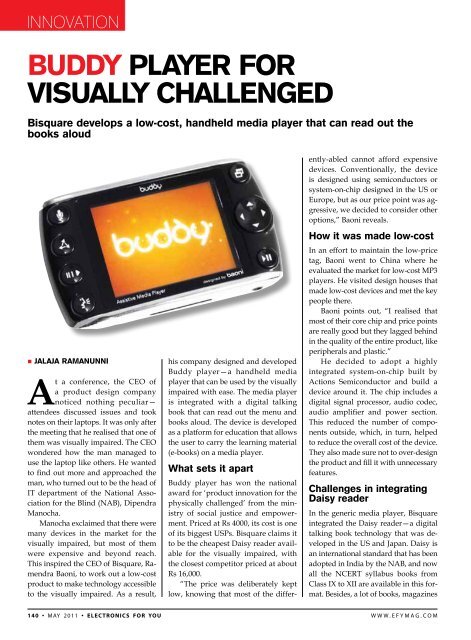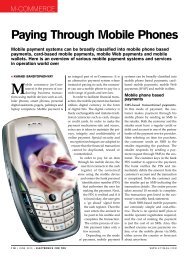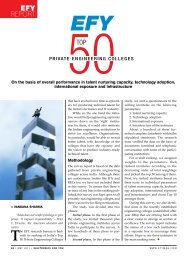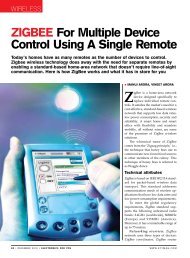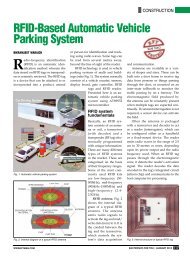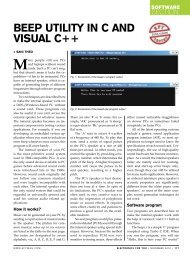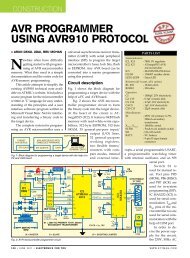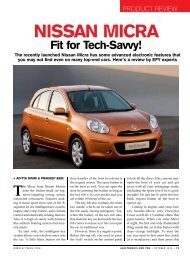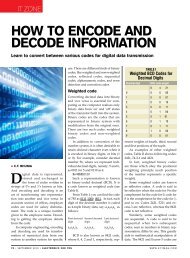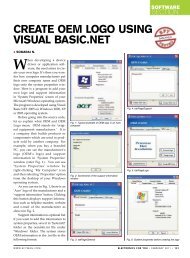Buddy player For Visually Challenged - EFY Magazine
Buddy player For Visually Challenged - EFY Magazine
Buddy player For Visually Challenged - EFY Magazine
Create successful ePaper yourself
Turn your PDF publications into a flip-book with our unique Google optimized e-Paper software.
Innovation<br />
<strong>Buddy</strong> <strong>player</strong> <strong>For</strong><br />
<strong>Visually</strong> <strong>Challenged</strong><br />
Bisquare develops a low-cost, handheld media <strong>player</strong> that can read out the<br />
books aloud<br />
• Jalaja ramanunni<br />
At a conference, the CEO of<br />
a product design company<br />
noticed nothing peculiar—<br />
attendees discussed issues and took<br />
notes on their laptops. It was only after<br />
the meeting that he realised that one of<br />
them was visually impaired. The CEO<br />
wondered how the man managed to<br />
use the laptop like others. He wanted<br />
to find out more and approached the<br />
man, who turned out to be the head of<br />
IT department of the National Association<br />
for the Blind (NAB), Dipendra<br />
Manocha.<br />
Manocha exclaimed that there were<br />
many devices in the market for the<br />
visually impaired, but most of them<br />
were expensive and beyond reach.<br />
This inspired the CEO of Bisquare, Ramendra<br />
Baoni, to work out a low-cost<br />
product to make technology accessible<br />
to the visually impaired. As a result,<br />
his company designed and developed<br />
<strong>Buddy</strong> <strong>player</strong>—a handheld media<br />
<strong>player</strong> that can be used by the visually<br />
impaired with ease. The media <strong>player</strong><br />
is integrated with a digital talking<br />
book that can read out the menu and<br />
books aloud. The device is developed<br />
as a platform for education that allows<br />
the user to carry the learning material<br />
(e-books) on a media <strong>player</strong>.<br />
What sets it apart<br />
<strong>Buddy</strong> <strong>player</strong> has won the national<br />
award for ‘product innovation for the<br />
physically challenged’ from the ministry<br />
of social justice and empowerment.<br />
Priced at Rs 4000, its cost is one<br />
of its biggest USPs. Bisquare claims it<br />
to be the cheapest Daisy reader available<br />
for the visually impaired, with<br />
the closest competitor priced at about<br />
Rs 16,000.<br />
“The price was deliberately kept<br />
low, knowing that most of the differently-abled<br />
cannot afford expensive<br />
devices. Conventionally, the device<br />
is designed using semiconductors or<br />
system-on-chip designed in the US or<br />
Europe, but as our price point was aggressive,<br />
we decided to consider other<br />
options,” Baoni reveals.<br />
How it was made low-cost<br />
In an effort to maintain the low-price<br />
tag, Baoni went to China where he<br />
evaluated the market for low-cost MP3<br />
<strong>player</strong>s. He visited design houses that<br />
made low-cost devices and met the key<br />
people there.<br />
Baoni points out, “I realised that<br />
most of their core chip and price points<br />
are really good but they lagged behind<br />
in the quality of the entire product, like<br />
peripherals and plastic.”<br />
He decided to adopt a highly<br />
integrated system-on-chip built by<br />
Actions Semiconductor and build a<br />
device around it. The chip includes a<br />
digital signal processor, audio codec,<br />
audio amplifier and power section.<br />
This reduced the number of components<br />
outside, which, in turn, helped<br />
to reduce the overall cost of the device.<br />
They also made sure not to over-design<br />
the product and fill it with unnecessary<br />
features.<br />
Challenges in integrating<br />
Daisy reader<br />
In the generic media <strong>player</strong>, Bisquare<br />
integrated the Daisy reader—a digital<br />
talking book technology that was developed<br />
in the US and Japan. Daisy is<br />
an international standard that has been<br />
adopted in India by the NAB, and now<br />
all the NCERT syllabus books from<br />
Class IX to XII are available in this format.<br />
Besides, a lot of books, magazines<br />
140 • May 2011 • electronics for you www.efymag.com
Innovation<br />
and newspapers are being converted to<br />
this format. It helps to create an HTML<br />
base content of the audio book and<br />
indexes its contents based on pages,<br />
sections, paragraphs, chapters, etc.<br />
This allows the visually challenged to<br />
navigate and bookmark pages.<br />
Bisquare designed and architected<br />
the <strong>Buddy</strong> <strong>player</strong>, but got the hardware<br />
and firmware implementation<br />
done by a Chinese design house. The<br />
software and user interface design was<br />
implemented internally with Mrinal<br />
Madhukar as the lead developer.<br />
“It is this collaborative effort that<br />
helped us bridge the barriers of language<br />
and bring down the overall<br />
price,” shares Baoni.<br />
Why is it suitable for the<br />
visually challenged<br />
At various stages, Bisquare interacted<br />
with Manocha and three visually impaired<br />
volunteers to test whether the<br />
product was user-friendly enough.<br />
“When a visually impaired person<br />
uses an audio book, he wants to listen<br />
to it at a faster speed as he cannot see<br />
the visual aid. The volunteers pointed<br />
this out and we added a hot-key for<br />
changing the tempo of the audio,”<br />
points out Hemendra Varshney, product<br />
manager.<br />
At one stage, one of the volunteers<br />
pointed out that the speaker should<br />
have been louder. So the amplifier was<br />
replaced with a high-voltage one.<br />
The device incorporates a power<br />
saving technology that works by using<br />
suitable colours on the screen. Baoni<br />
elaborates, “The colours of the user<br />
interface can make a lot of difference<br />
in the power consumed by the LCD.<br />
In the user interface, we have used less<br />
bright colours to reduce the power<br />
consumption. Another power saving<br />
feature is the shutdown mode that<br />
switches off the applications which<br />
have not been used for a while.”<br />
<strong>Buddy</strong> <strong>player</strong> is powered by a<br />
lithium battery that is easily replaceable<br />
and readily available at electronics<br />
stores. This increases the life of the<br />
product and also brings the maintenance<br />
cost down.<br />
<strong>Buddy</strong> <strong>player</strong>’s screen shows text<br />
in a large font size and uses contrasting<br />
colours. “We have implemented this so<br />
that people suffering from low vision<br />
or dyslexia can easily differentiate the<br />
text from the background and read easily,”<br />
Baoni informs.<br />
An asymmetrical design of the<br />
device helps the users to identify<br />
buttons without confusion. There are<br />
three buttons on the right and four<br />
on the left. Menu navigation has been<br />
made simple with fewer searching<br />
commands.<br />
The <strong>Buddy</strong> <strong>player</strong> can also be<br />
used to record discussions in class for<br />
reference during revision. It comes<br />
with an internal microphone and also<br />
a slot for an external microphone.<br />
This slot was provided keeping in<br />
mind that the visually impaired<br />
would prefer recording voice notes<br />
to writing down, especially in classrooms.<br />
The <strong>player</strong> records at a low<br />
bitrate, which enables the user to<br />
record much more content.<br />
“Normally, media <strong>player</strong>s do not<br />
pay much attention to the recording<br />
feature but we have prioritised<br />
this feature. The <strong>Buddy</strong> <strong>player</strong> also<br />
gives a superior quality of recording,”<br />
shares Hemendra. The <strong>player</strong><br />
comes with an optional voice-based<br />
suggestive menu that gives prompts<br />
at every step.<br />
Though the device has been designed<br />
for the visually impaired, it can<br />
be used by anyone as a media <strong>player</strong><br />
with an e-reader for edutainment.<br />
Future plans<br />
“In the future, Bisquare plans to build<br />
a model with capacitive buttons on<br />
the body. Once you touch it with your<br />
finger, it will announce the prompt,”<br />
Varshney concludes. Bisquare is also<br />
planning to launch a tablet that can be<br />
used easily by the visually impaired.<br />
It will be based on the same technology<br />
as the <strong>Buddy</strong> <strong>player</strong> but include a<br />
touchpad. •<br />
The author is from <strong>EFY</strong> Bureau, Bengaluru<br />
www.efymag.com<br />
electronics for you • May 2011 • 141


